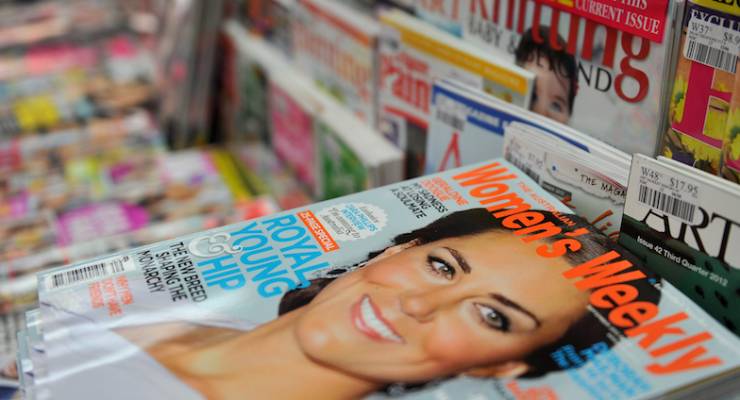
Magazines — that most tactile, visual and culturally significant of Australian print media — look close to vanishing from the local landscape. While we’re busy chattering about regional newspapers, perhaps we should be as concerned — maybe more — about the survival of Australia’s once-rich magazine ecosystem.
Early last week, Australia’s major magazine publisher, the German-owned Bauer Media, announced it was making 70 employees redundant and standing down a similar number of staff. It plans to “suspend” certain titles. The company had already slimmed down its products and reduced the freelance content on which magazines have long relied.
At the end of the week, Bauer confirmed that it had finalised the purchase of the second largest magazine publisher: Pacific Magazines, previously owned by Seven West Media (and before that, until 2002, by News Corp). There is significant masthead overlap in the two companies. This includes the two leading weekly magazines, Woman’s Day (Bauer) and New Idea (Pacific Magazines). In the current (and foreseeable) market, this is likely to lead to further closures.
The Australian Competition and Consumer Commission (ACCC) initially raised concerns about the impact on competition from the merger but, in March, it waived it through with a “what you gonna do?” shrug. As ACCC chair Rod Sims acknowledged: “some magazine titles have already closed, and others are likely to follow, regardless of this deal”.
“The significant declines in the circulation and revenue experienced by many magazines are sustained, substantial and likely to continue, resulting in less investment in content and fewer retail promotions,” Sims said.
Within a week of Sims’ announcement, Bauer proved him right with the closure of its New Zealand publications, including the local editions of its Australian titles, such as Woman’s Day. NZ PM Jacinda Ardern echoed Sims when she noted that the closure was happening during the pandemic, but not because of the pandemic.
New Zealand is not the only country to lose the bulk of its magazine ecosystem in one go. Last week Malaysia’s major magazine publisher, Blu Inc Media, announced it was shutting down its 19 publications, including the Malaysian editions of global brands like Harper’s Bazaar and Marie Claire.
Australia’s magazines took a further hit last month when literary and cultural magazines including Australian Book Review and Overland were de-funded as part of the cuts to Australia Council support for the arts. This is a significant hit as the literary magazines have increasingly been filling the journalism gap left by commercial magazines. They have also supported a diverse and emerging network of freelance writers.
For example, the most recent issue of Australian Book Review featured perhaps the most powerful take on the disease from the inside with “Notes on a Pandemic” by Hessom Razavi. His terse opening jerks you upright: “I was operating when it arrived. Between patients, I read the email hastily.”
The disappearance of magazines has been hidden by what’s come along in their place: content marketing dressed up as magazines. In metaphorical terms, they’re more like skeuomorphs — designed to look like the real thing, but made up with very different content. Think the “magazines” provided by the big two supermarkets, the airlines (sorry, airline, singular) and the various state-based motorists associations.
The decision by the major magazine publishers to stop auditing circulation in 2016 has made it hard to track their decline. But last financial year, Bauer Australia revenues declined by 13.7%. It’s a figure that confirms the Sims/Ardern take: magazines were in trouble, long before the COVID-19 shock.
As for other mediums, the shock has been a mixed blessing. Readership and attention is up, boosting subscriptions and sales of certain categories: puzzles, cooking, gardening — even glossies that can bring a light escapism. In the US, news-based magazines like The Atlantic have carved out a niche with deep journalism and expertise.
As Conde Nast head Wolfgang Blau tweeted after Vanity Fair Italy’s in-depth take on the crisis was rewarded with a big sales jump: “Relevant journalism works”.
But the collapse of print advertising has meant that in smaller markets like Australia, there’s no apparent workable business model for local magazines on the other side of the crisis.









So the lying newspapers are disappearing along with the lying magazines and the Murdoch journo puppets that promote their lies, good riddance, let them join the unemployment queues and the unemployed they have victimised for their right wing masters at every opportunity everytime this coalition of political corrupt liars gain office .
It would be fun to be a CES scrutineer when some hack turns up with NewsCorpse on their CV.
Technology has move on, and the days of print medium – be it newspapers, magazines or whatever – as a dominant means of information transmission have passed. I have no doubt that print will survive as a niche product, in much the same way that vinyl disc pressings are still in demand amongst music cognoscenti, but that will scarcely be sufficient to support professional journalism to the extent that it’s enjoyed in the past.
Today’s punter has access to an almost unlimited supply of word vomit, thanks to the internet. While the quality of this work is, for the most part, highly suspect, the law of supply and demand dictates what happens to price as the ratio of supply to demand tends towards infinity: it drops to nothing.
Journos need to find another job.
I was amazed before the Internet age at the large market for material like women’s weekly. It’s loss would be missed fleetingly.
I get there’s a market for this type of publication but the internet has it well covered.
All large commercial media is in the advertising business. There are gradations but it’s about ads first with articles, music or shows in between. The strength of classy print media is it can make ads and content feel more seamless as the top line fashion glossies do. At the other end is commercial radio.